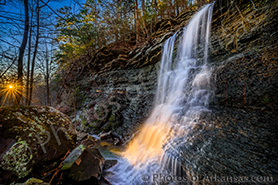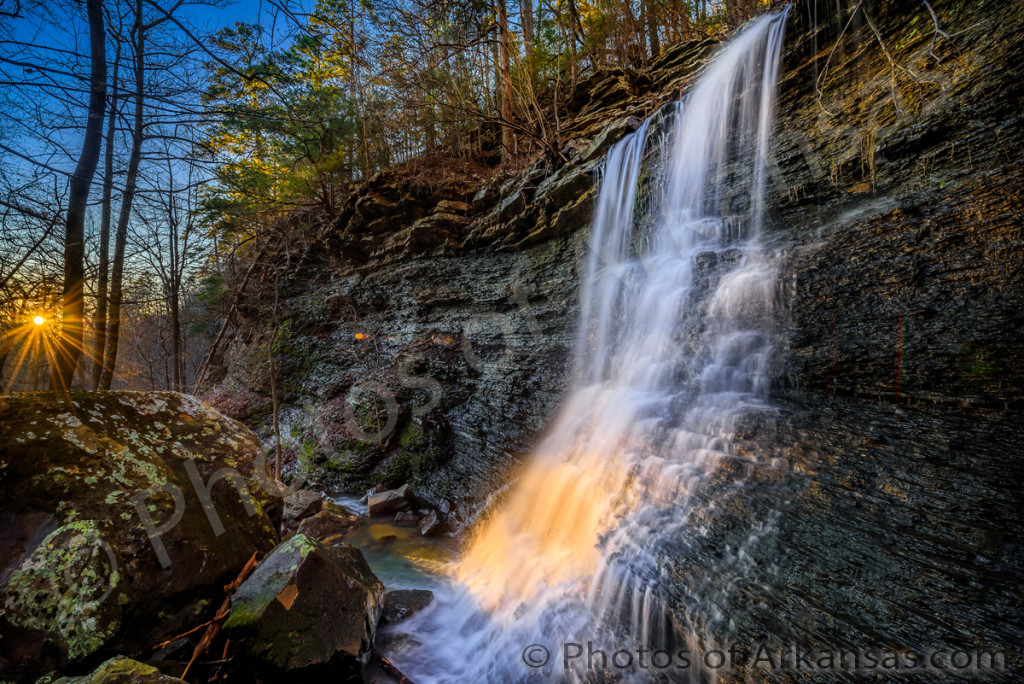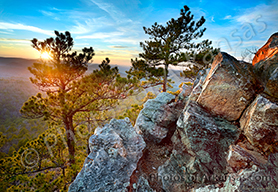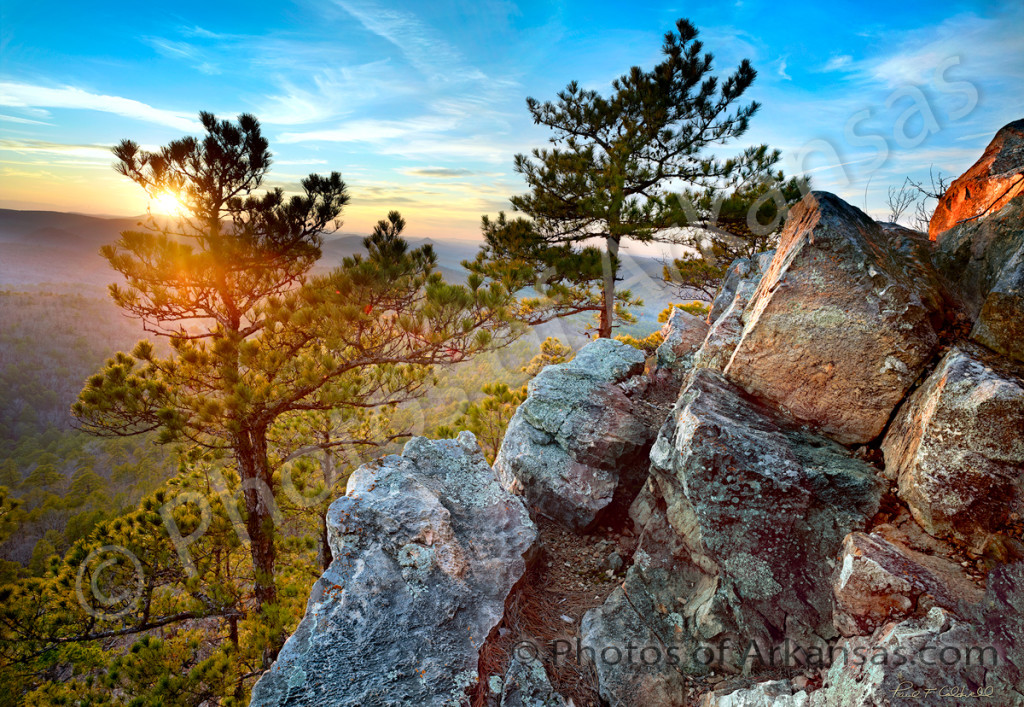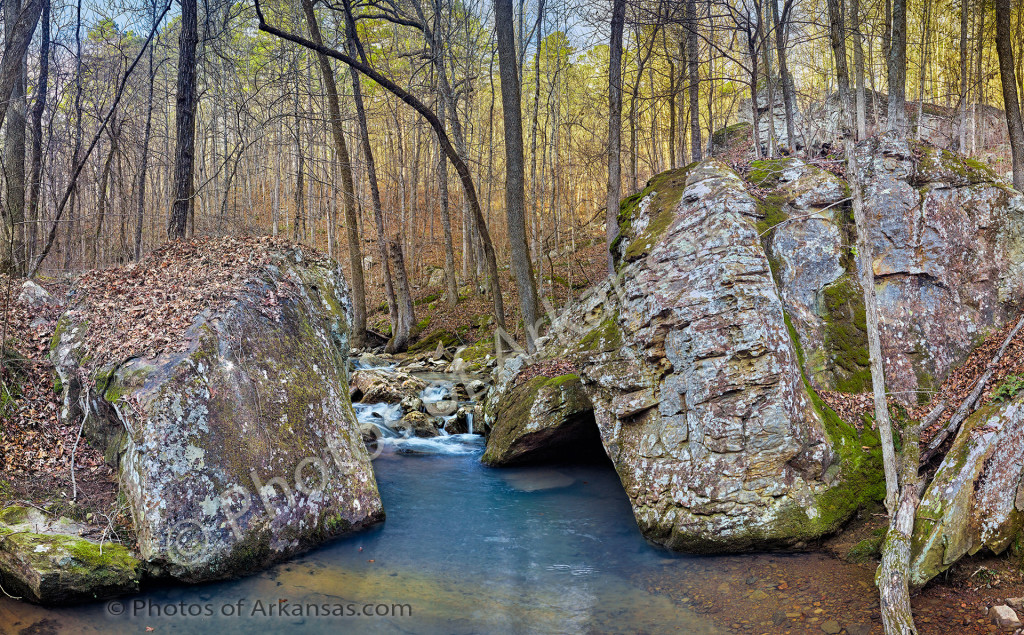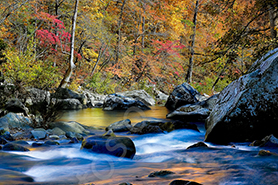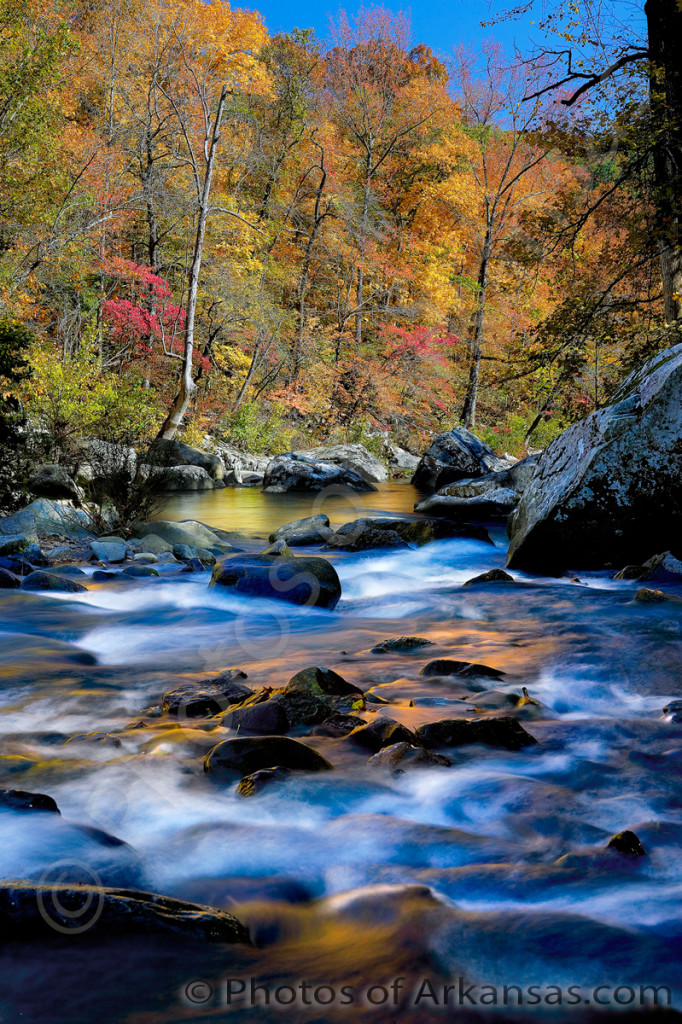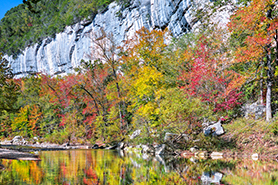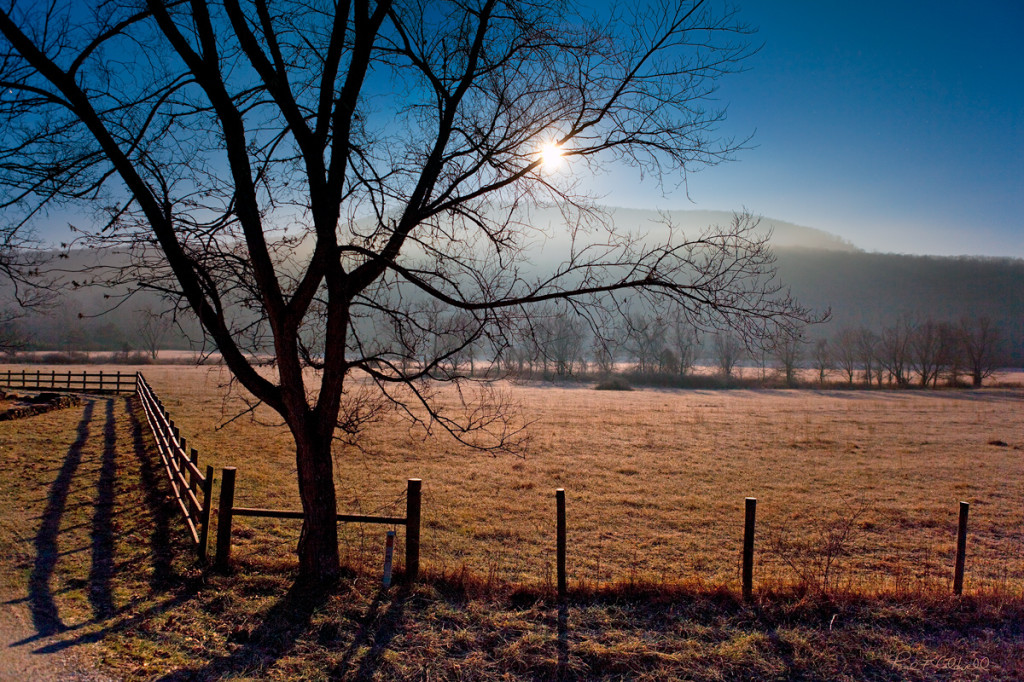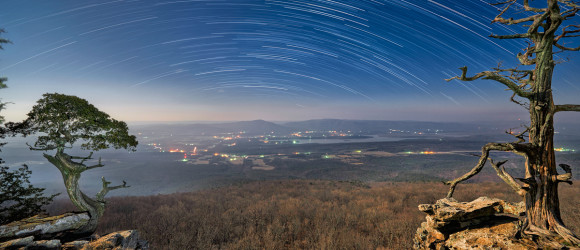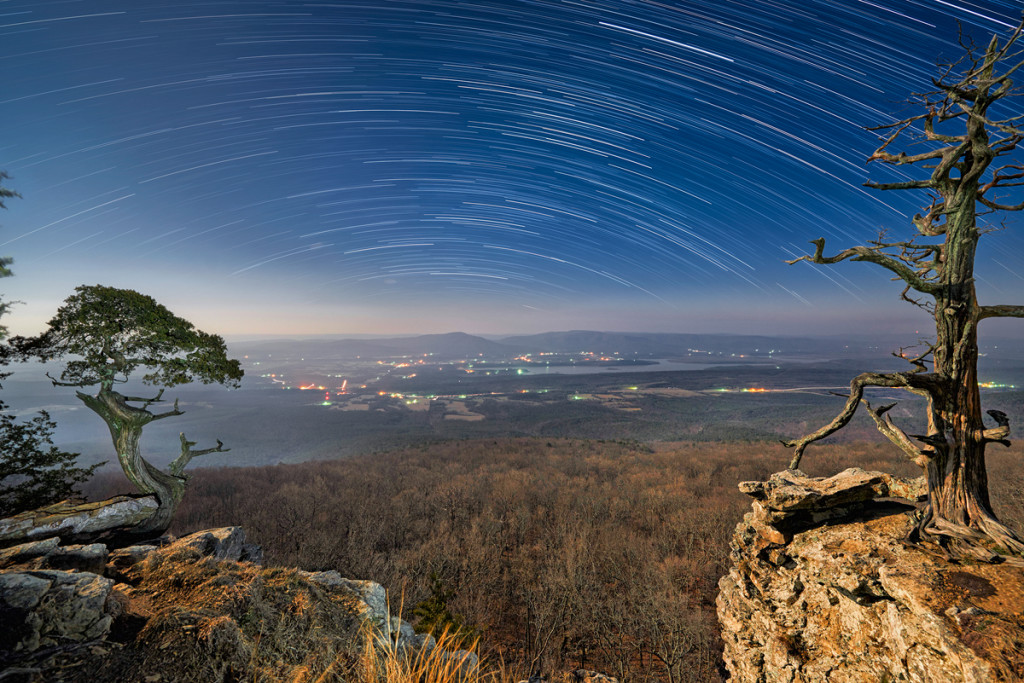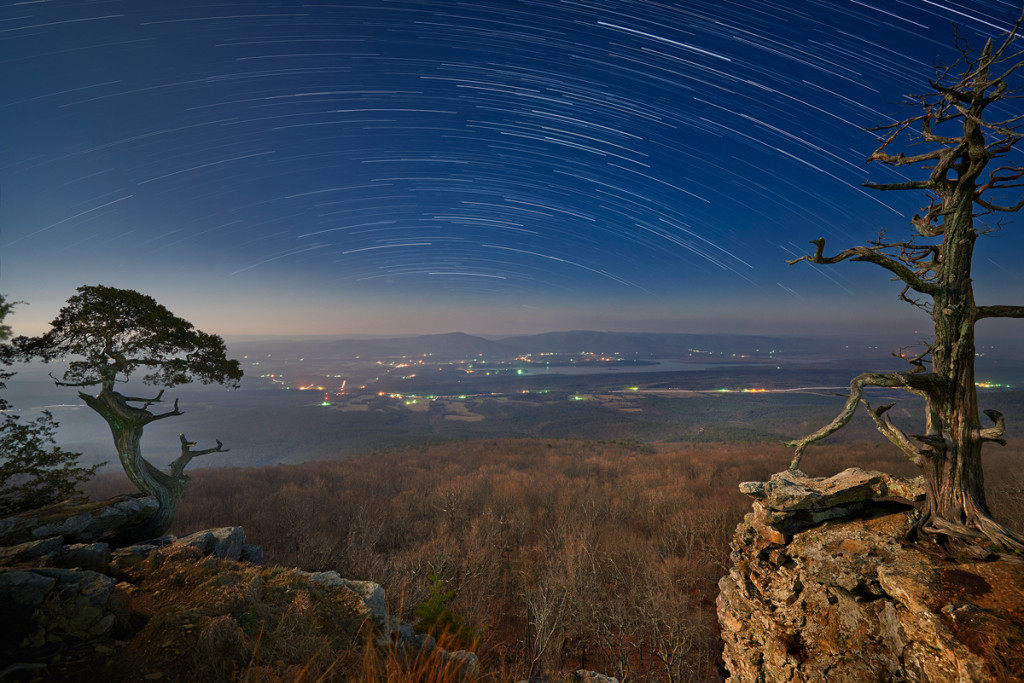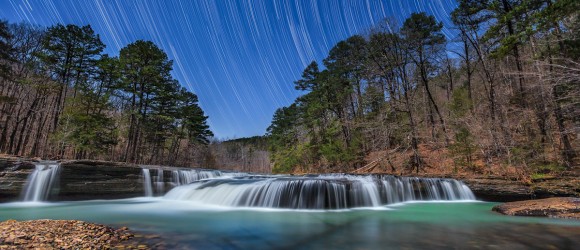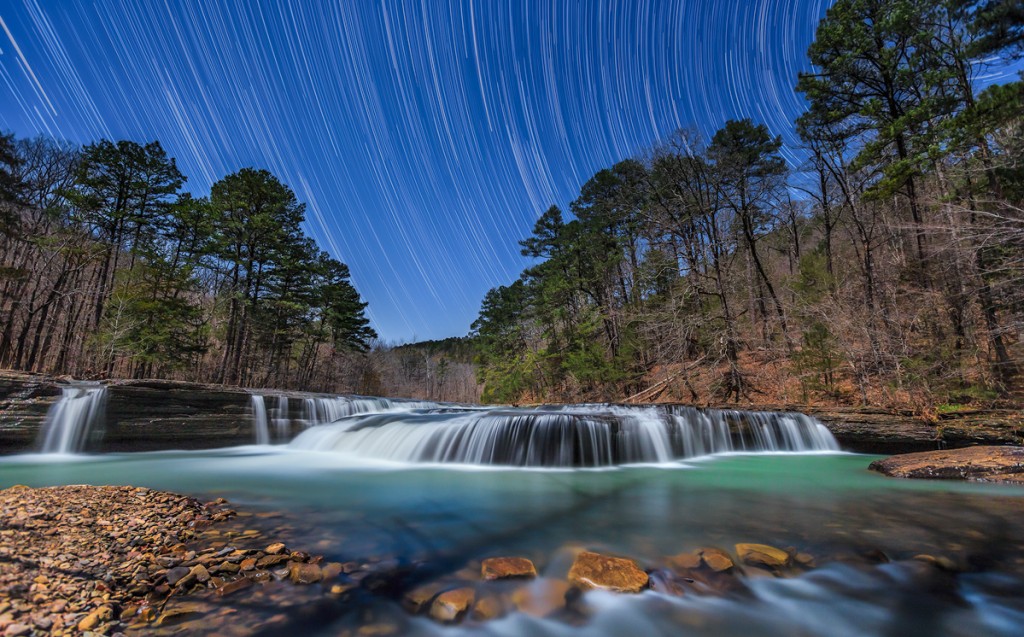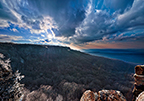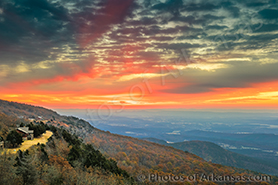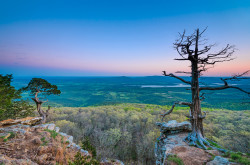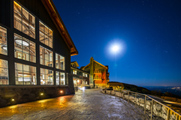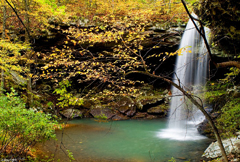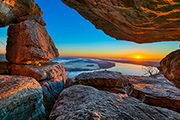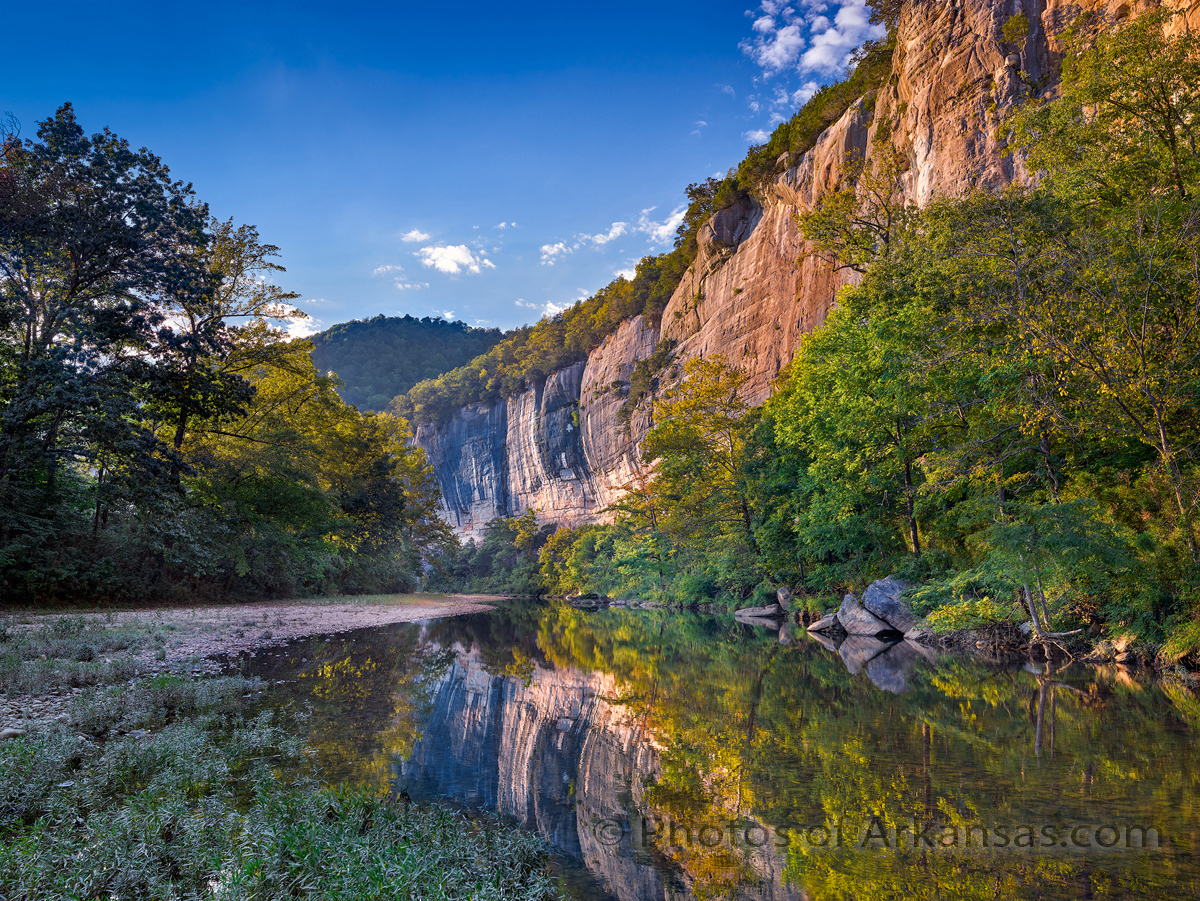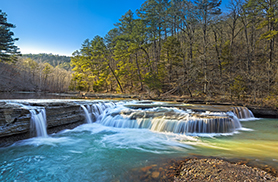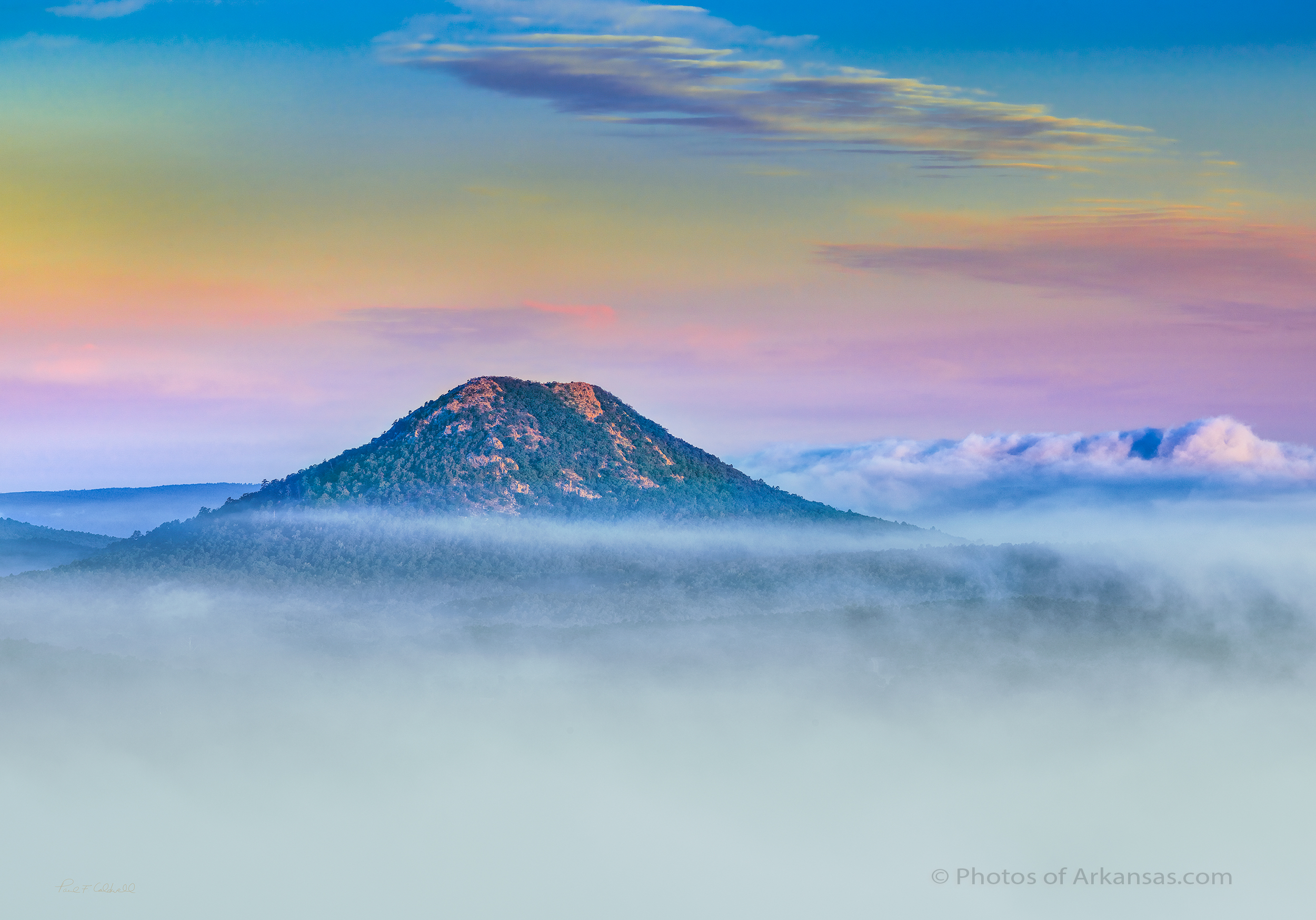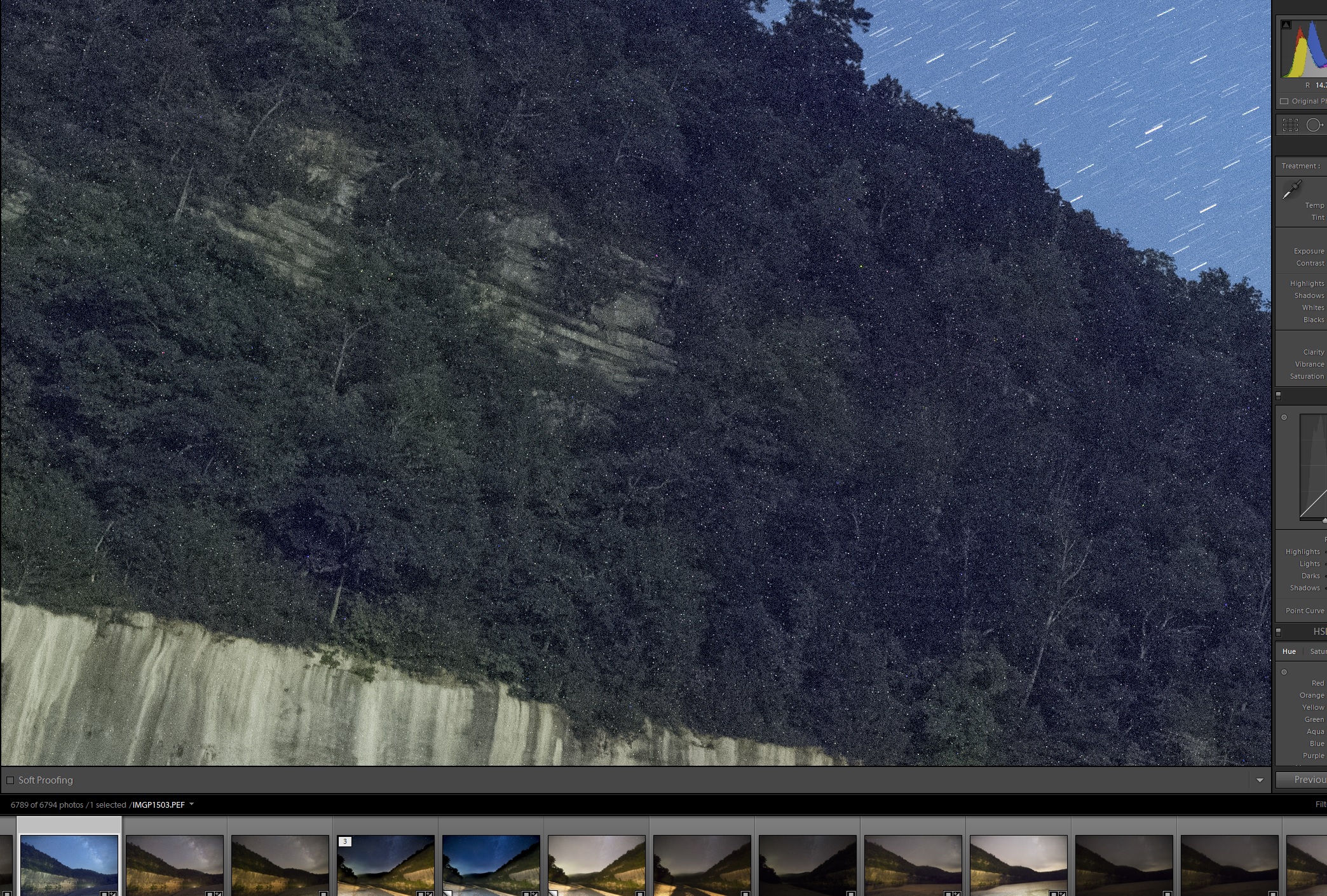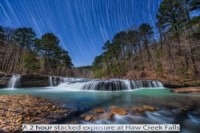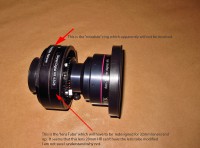06/18/16 Featured Arkansas Landscape Photography–Nighttime skies over Falling Water Creek
- At June 18, 2016
- By paul
- In Featured Arkansas Photography
 0
0
Taken with a Nikon D750, ISO 3200, 15 seconds with a Nikon 14-24 lens at 14mm F 2.8 for main night sky and a series of shorter exposures to blend in the lantern and water.
Working with the night sky can be easy and hard and on this night it was a combination of both extremes. I was working with Chris Kennedy at Falling Water Falls in the Arkansas Ozarks. Falling Water Falls is one of the more known spots and very often has a lot of folks either swimming or just hanging around. But at midnight, I have yet to run into anyone (at least human). I have thought about this spot many times for either star trail work or the Milky way and have successfully taken many star trail shots here, but have never worked the Milky Way. The conditions for the best Milky Way shooting are a moonless night or as close to it as you can get. On this night Chris and I were working with a very small amount of moon less than 16% and we both hoped that this amount of light would not effect the Milky Way’s luminace, but we were wrong. As soon as the last of the sunlight was gone, we could quickly see that there was quite a bit of light being provided by the 16% moon, which was setting directly behind us. On this night, June 8th, the Milky Way was due south and very faint at first. This was as strange night as there was too much moonlight to really see the Milky Way but the stars were amazingly bright. Also this small amount of moonlight did not provide very much light to the falls and surrounding area, so we quickly fired up a lantern.
The night was very muggy and dead calm. Normally I want dead calm, but as soon as I fired up the lantern every bug in the area made a bee line for the light and for the rest of the night we were covered in bugs. There were also a lot of lightening bugs and they added a strange effect to a lot of the star stacks. We kept looking for the Milky Way to the southwest as both of our star tracer apps were pointing us that direction but we could not see it. After working for about 1 hour I happened up to the top of the falls and for the first time could really see that the Milky Way was off to the southwest and very low on the horizon. Strange!, but still possible to shoot.
We quickly left out spot on the far side of the falls. We had set up here as it was the only only place to really get a clear view of the sky below the falls. Once on top on the large ledge that creates Falling Water Falls, we could clearly see the Milky Way just over the tree line. The moon was so low in the sky now that it was not providing any illumination at all, so Chris walked out on the ledge and held the lantern. It really made the shot in that the lantern provided just enough light to the immediate parts of the trees and gave a very nice fade out. The trick was holding the lantern totally steady for the 17 seconds required to shoot the sky. We actually both tried this for each others shots and it came out very nicely. I have left one piece of lens flare in this shot as it’s not really hurting the shot. The 14-24 will flare always, when given any chance. This will be an easy one to take out later.
I used the Nikon D750 for this shot and I was very impressed! The ambient temperature was around 70 degrees F and the relative humidity had to be 100%. I shot the entire sequence at ISO 3200 with the 14-24 wide open at F2.8. The longest exposure I used was 20 seconds and there was just a bit of trailing on the far sides which I did take out with a custom brush in Photoshop. At 20 seconds I was just able to get enough of the unique color of the Milky Way, however the rest of the frame was totally blown out due to the lantern. So I then shot a series of short frames the shortest exposure @ 6 seconds and then combined various elements from 3 different shots to get the final work. There was no wind blowing or very little most times so the leaves are not blurred and can add a nice effect. The lantern added a very warm tone to the trees and water so I also tweaked that back to a more neutral tone.
Overall I am pretty happy with this attempt. If there had been much more water coming over the falls, then all the trees below the falls and on the side would have been moving due to the force of the water. The lantern captured the nice green color of the water which is common to all Arkansas streams this time of year. For the Milky Way, I spent the most amount of time as it was just barely showing so I used several different adjustment brushes in Lightroom to help bring out the colors and different tones common with the nightsky. The stars were very bright this night and they add a very nice contrast to the night sky above the Milky way.
02/25/16 Featured Arkansas Landscape Photography–Sunset Falls on Mt. Magazine aka Chris Kennedy Falls
PLEASE NOTE: All of the photography of this website is the property of www.photosofarkansas.com and is copy right protected. Do not copy any of the images on this site to paste on Facebook, Pintrest, or any other website without the permission of Paul Caldwell. Years of time have gone into capturing these photographs, please respect that. I do not take copy right infringement lightly. If you have a need to display any of my work on your site ASK me before you Copy & Paste.
Taken with an Nikon D810 & 14-24 lens @ 14mm, F11 ISO 64 through 400 in a series of bracketed exposures, combined into a single photograph in Lightroom.
In Yosemite National Park, there is a famous spot where during the month of February you can catch the setting sun illuminating a slender waterfall. Once the angle of the sun moves past a certain point the light falls beyond the waterfall. The problem is there tends to be over 1000 people lined up to get the same shot, so it’s really become a common shot. Still a thrill to get, but 1000’s of copies floating around the internet and in various galleries.
By pure chance, one of my friends, Chris Kennedy found this place on Mt. Magazine. I am sure this creek has a name, but I felt it fair to give Chris title. I have seen thousands of waterfall shots taken in Arkansas, but I have never seen one that features the setting sun, both in the shot and illuminating the waterfall. I knew of a different spot a bit further down on Highway 9 and had mentioned this to Chris to check out. During that trip, he found a second series of waterfalls, just up the highway, and while he was photographing them, he realized that it was possible to catch the sunset on the waterfall. Chris sent me a shot the next day and I was transfixed! Chris mentioned to me in passing that the trip to the base of this waterfall was about like the hike down Big Devil’s creek from Hill Cemetery, a hike I had made many times, so I was not too worried about it. I had a lot to learn.
Highway 9 heads up the south side of Mt. Magazine out of Havana Arkansas. On the way up you will cross several small creeks that really just runoff from the summit of the mountain. The largest creek in the area Shoal, starts up on the other side of Magazine and runs to the north. As you wind up Hwy 9, you will come to a spot where two small creeks cross the highway and then come together. This spot has obviously been photographed many times before as there is a worn down trail to a vantage point. This creek now bounces down a very steep gorge over many more waterfalls, and disappears out of sight headed south. While walking along the highway, Chris spotted a higher waterfall, much further down the creek, and headed down the hillside to get a better view and in the process discovered this wonderful view.
The waterfall, is actually in 3 parts and in this photograph, you are viewing only the top part of the waterfall, which is also the highest single point. It’s about 20 to 25 feet tall from the very base. The creek then winds around the shale bluff and makes two more nice drops before emptying into a nice pool. The sun in January, is at just the right angle to shine on the base of the falls, providing a beautiful shot. Chris told me that you only have about 10 minutes to catch the light before the best part of it moves away from the falls.
I headed up to this spot with Dr. Todd Smith, (and will tell more of that story on my blog), and we were both able to get to the base of the falls just in time to catch this shot.
A few points of consideration:
- This waterfall has one of the most dangerous approaches I have ever attempted in Arkansas in over 40 year of hiking this state. You are hiking down a pitch of at least 55 degrees or more at times and it’s all loose rock
- About 1/2 of the way down you will hit a band of large loose rock that is full of pitfalls and places to break your ankle, there is an old crashed car laying in this part of the decent. This is a steep enough spot that if you lean too far backwards, you will fall.
- The last 20 feet to the base of the waterfall is along a 55 degree pitch, where if you slip, you will be headed straight down to the bottom 10 feet below. The area is just a muddy hillside and very slick
- When you are photographing the waterfall, you need an extremely wide angle lens, and a full frame sensor, (no APS-C cameras) if you want to get both the full waterfall and the setting sun. I used a 14mm lens
- Make sure to pack a series of filter and a tripod as this shot has to be bracketed.
- The trees above the waterfall are moving all the time due to the force of the water, so plan on shooting at least one frame at a faster ISO and shutter speed to stop the motion
- The hike out, well, lets just say it’s not for the faint of heart. It’s ten times worse than the hike down as the entire hillside is just loose rock, so you may climb 3 feet just to slide back 1.5 feet. The use of a rope on the last 50 feet would be strongly advised and something I plan to bring the next time I attempt this shot.
- You can try to come at the falls from a little bit further down the highway, but trust me the going is not any easier as the forest floor is just a bunch of broken rock and it make for very difficult footing.
- It’s very apparent that some blasting was done for the Highway above here and the rock just all fell away down the hillside and is very loose, footing is very tricky.
Overall this has to be one of the more unique places I have ever worked in Arkansas and have been to many. I would not attempt this hike alone, as there is just too much a risk, and I was glad to have Todd and Chris with me both times I headed down to the falls. This hike will give you just a bit more appreciation as to just how high Mt Magazine is and steep. The result is well worth the hike.
Paul Caldwell
02/14/16 Featured Arkansas Landscape Photography–Sunset from the summit of Flatside Pinnacle
PLEASE NOTE: All of the photography of this website is the property of www.photosofarkansas.com and is copy right protected. Do not copy any of the images on this site to paste on Facebook, Pintrest, or any other website without the permission of Paul Caldwell. Years of time have gone into capturing these photographs, please respect that. I do not take copy right infringement lightly. If you have a need to display any of my work on your site ASK me before you Copy & Paste.
Taken with a Phase One IQ160 Medium Format Back and Arca rm3di/28mm Rodenstock Lens, image was captured in a bracketed series of exposures.
I have featured this image many times, but it’s still one of my favorites. I took this shot in January 2011 with a “tech” camera an Arca rm3di, with a Rodenstock 28mm lens. This view has since been ruined by graffiti, which was painted all over the rocks. I have slowly tried to removed it over the past 2 years, and have made some progress, however to the assholes that did it, **uk you.
Flatside Pinnacle is the key point in the Flatside Wilderness, and is right in the middle of the Quachita mountains. Looking in the shot between the two pine trees you can see Forked Mountain off in the western distance. Towards the middle of summer, you can catch the sun setting over the top of Forked Mountain. Flatside itself is around 1,500 feet tall, which make it taller than both Mt. Nebo, (near Russellville) and Petit Jean Mountain. The good news is that you don’t have hike very far to get to the summit as a road takes you almost all the way to summit. The Ouachita trail comes very close to Flatside also. The view from the summit has to be one of the best in Arkansas. Here looking to the west you can see Forked Mountain, and off to the right, Mt. Nebo, Spring Mountain, and the grandest of all Mt. Magazine, which is over 2,700 feet tall.
Flatside is great spot to catch a sunset, however if you want to get the best light try to get there before 11:00 am as after that you will be shooting into the sun. If there are some clouds, you may still get away with a great shot. Take a lunch and sit out on the rocks and enjoy the day.
02/05/16 Featured Landscape Photography–Wintertime on White Oak Mountain near Hector Arkansas
PLEASE NOTE: All of the photography of this website is the property of www.photosofarkansas.com and is copy right protected. Do not copy any of the images on this site to paste on Facebook, Pintrest, or any other website without the permission of Paul Caldwell. Years of time have gone into capturing these photographs, please respect that. I do not take copy right infringement lightly. If you have a need to display any of my work on your site ASK me before you Copy & Paste.
Taken with a Phase One XF camera & IQ260, 55mm LS lens and CL-PL. Image is composite of 3 vertical images with the 55LS set to it’s nodal point.
This past winter I started trying to find some new places to photograph in Arkansas. I have worked Falling Water Creek and Richland for years and still love that part of Arkansas, but I felt it was time to move on. I had heard a lot about White Oak Mountain from Chris Kennedy and wanted get a look at the area in winter. If you hike into a spot in Arkansas for the first time, I always recommend coming in winter or early spring as you will see a lot more of the surrounding areas. Later on in summer the trees will hide a lot and the undergrowth makes hiking in general much harder.
White Oak Mountain, is actually a long ridge that runs east and west near Hector Arkansas. To get there, you need to drive to Hector, through the town and as soon as cross a small bridge over a minor creek, you will see a dirt road heading up to the right. Stay on this road for about 7 miles, there will be some turn offs but once you find the right spot, you can hike right down into a great creek valley. This creek has a nice run which offers several nice smallish waterfalls in quick succession. If you hike up the far hillside, you can find some much more dramatic waterfalls, but these will only be running after a locally heavy rain.
What I found most interesting on White Oak mountain was the number large boulders that were just laying in the creek. This reminded me of Richland creek, however the terrain is a bit more open than on Richland.
Once you are done in the creek valley walking is very easy and you can make good headway. There is a RV trail and a marked hiking trail that will take you down to the creek. This creek outwardly appears to be about 1/5 the volume of Richland creek, but the unique geography surrounding the creek makes the hike worth a trip. I would warn anyone that crossing this creek in high water could be a bit dangerous as the bottom is full of large mossy rocks easy to slip on.
I hope to make another trip here in the future to see what the area looks like in Spring with more water running.
To capture this photograph, I used a Phase One XF camera with a IQ260 Medium Format back and 55mm LS lens. The photograph was taken with a nodal panorama setup and I used the captures to make the one horizontal shot. To slow the water down I used ISO50 on my camera and a polarizer. As you can see in the photograph, the light was already marching up the far side of the valley, so I did not need a ND filter. The raw files were converted in Capture One software and then I used PtGui to stitch the 3 images together. I then added a bit of Topaz clarity to my liking.
12/18/15 Featured Arkansas Landscape Photography–Late afternoon on Richland Creek
Taken with a Canon 1ds MKII, 24-70 Lens, @ 24mm, with a CL-PL and ND 1.2 filter, ISO 100 for 2 seconds foreground and 1/250 background.
What can I say about Richland Creek, it’s one of the rare gems in Arkansas. The Richland Creek wilderness was established in the 1970’s and has a huge outdoor appeal. The creek offers fishing, hiking, kayaking and of course photography. I have been hiking up Richland for the past 25 years and hope I can make a few more trips before my knees give out. I have probably shed more blood and gear on this creek, having taken several bad falls and breaking at least 4 cameras or lenses over years. But to me it’s worth it.
Richland is the 3rd or 4th largest tributary of the Buffalo and comes into the Buffalo at Woolum Ford. It’s headwaters are about 25 miles due west from Woolum. The best parts of Richland are the 6 miles from Moore to the Richland Creek Campground and the following 10 miles downstream to the low water bridge. The creek is very isolated and you can expect to cross it several times on your hike upstream. Going upstream from the campground, look for a trail on the left side of the creek. Since Richland is in Wilderness, the Forest Service will not make a permanent trail (STUPID), BUT THAT’S THE GOVERNMENT. You can find the make shift trail on the left bank pretty quickly as most of the time it stays within sight of the creek. From the campground up to the big bend where Big Devils Creek comes in, you will find over 20 major rapids most of which have a name.
You can hike Richland anytime of the year, but make sure the water level is running about 400 CFS (cubic feet per second) or less. Anymore than this and you can have a lot of trouble crossing the creek. Be careful when crossing as the creek bottom is mainly limestone and slick. The hike from the campground to Richland Falls is about 2.0 miles but plan to spend extra time along the creek. There are not many other places in Arkansas where such a beautiful creek runs by house sized boulders.
PLEASE NOTE: All of the photography of this website is the property of www.photosofarkansas.com and is copy right protected. Do not copy any of the images on this site to paste on Facebook, Pintrest, or any other website without the permission of Paul Caldwell. Years of time have gone into capturing these photographs, please respect that. I do not take copy right infringement lightly. If you have a need to display any of my work on your site ASK me before you Copy & Paste.
12/14/15 Featured Arkansas Landscape Photography–Fall view below Big Bluff on the Buffalo River
Taken with a Phase One P45+ and 35mm F 3.5 lens, ISO 50, 2 exposures-one polarized and one non-polarized for reflections.
The Buffalo River has numerous bluffs along it’s entire length, but Big Bluff is the tallest at well over 550 feet tall from the river. Big Bluff is famous for the goat trail, which is a narrow shelf of rock that cuts across the middle Big Bluff. At a few points it’s barely 4 feet wide and the edge is straight off. Since the road down to Big Bluff from Hwy 21 was closed, you now have to hike down from the Compton Trail head and that is a major hike. The trail itself is at least 2 miles to the goat trail, and it’s all up hill on the way back. There is no water on the trail unless you happen go during a heavy rain so plan to bring some.
The best view is not from the the goat trail, but instead from the bottom of the bluff. Here in the fall you can catch some wonderful reflections along the river bank if the river is calm. On this day, I hiked in from Steel creek and waited for about 2 hours for the wind to die down. The wait was well worth it as the sunlight improved and the tress on the far bank were just lit up. It’s very interesting to note, that only the trees along the river were starting to turn and the trees up towards the top are still mainly green.
I used a Phase One P45+ back to take this photograph. I used a tripod mainly since I was going to bracket the shots. I wanted to use a polarizer to help cut the glare off the trees but I also knew that the polarizer would cut down on the reflections. So it was a simple thing to take two shots bracketing and then combine them later in Photoshop. This hike from Steel creek is a about 1.5 miles one way and you have to cross the Buffalo several times, so plan to make this trip on a low water day, or from a canoe.
PLEASE NOTE: All of the photography of this website is the property of www.photosofarkansas.com and is copy right protected. Do not copy any of the images on this site to paste on Facebook, Pintrest, or any other website without the permission of Paul Caldwell. Years of time have gone into capturing these photographs, please respect that. I do not take copy right infringement lightly. If you have a need to display any of my work on your site ASK me before you Copy & Paste.
Moonset in Boxley Valley on the Buffalo National River–02/18/15 Featured Arkansas Photography
Taken with a Canon 5D MK2, Canon 24-70 lens at F5.6, iso 400 for 40 seconds.
This photograph was taken in early January 2009, back in the good old days for me at least, (if you know me well, you know what happened in February of 2009). I was on a trip to photograph Elk in the Boxley Valley and this was my first field use of my new Canon 5D MK2. Before I purchased the Canon 5D MK2, I had been using my older Canon 1ds MKII, which just did not have a very good higher iso range. On this morning, I came around the last bend of Hwy 21 as it drops down into the western end of the Boxley Valley and saw this view of the moon setting over one of the larger mountains that surround the valley. What caught my eye was how the shadows played with the fence row in the foreground. The old oak tree provided a nice touch also as I framed the shot between the branches. You can see just a very light layer of clouds or fog that was starting to rise up over the mountain in the background.
When you view this photograph up close, you can also see all the frozen dew drops on the grasses and fence posts. If you have never taken a trip to the Boxley Valley, which is on the western headwaters end of the Buffalo National River, it’s well worth the time.
Nighttime skies over Havana Arkansas revisited–02-09-15 Featured Arkansas Photography
Taken with a Nikon D800e, 14-24 Lens @ 15mm and F 3.5 in a series of stacked exposures. This shot was taken in February of 2013 on a very clear night from the summit of Mt. Magazine. The view is directly to the south looking over Havana Arkansas. In the distance you can see Blue Mt. Lake and Blue Mountain itself. I believe that Blue Mt. is the on the left. It would be a tall mountain if not for Mt. Magazine as Magazine dwarfs Blue Mountain.
This is one shot but it was composed by taking around 30 or so stacked exposures of 45 seconds. I had a 3/4 moon that night so the illumination down into the valley is all from the moon. I did some light painting on the tree on the left as the moon light was not going to get there until much later. I did not want to wait that long as by the time the moon would provide that illumination it would also be causing both flare and over exposure issues. This night there was quite a bit of traffic down in the valley along Hwy 10, but it just adds to the overall effect to me. I am always amazed when I look down into this valley during the day it’s hard to see any building of significant size, but at night even the smallest light will show up.
I first worked this shot up back in 2013 and thought I had a good version. Recently when viewing that shot, I realized that I had not been very accurate with the star trail work, and in fact I had a dip. This happens when you just slightly move the camera. It doesn’t take much to offset the trails. The best bet is just don’t touch anything until you are done. I say that, but I usually have to stop the series somewhere in the middle to see if I am getting some damaging flare. The Nikon 14-24 will flare with any amount of light that hits the outer element from the side and the flare can be very destructive and next to impossible to correct in post processing work. Flare tends to totally shift the blue of the sky to a red or yellow hue and tend to have a very hard demarcation which makes removal quite difficult.
Here is my first version of this work, and I greatly prefer the new one. I was able to pull out a lot more of the details in the valley. I also re-worked each of the images to try and pull out more of the trails on the left side. In this location the moon will pass from the left side to right and thus makes an even exposure pretty hard to obtain. However working in Lightroom and with some filters I have I pulled out more definition from the faint trails on the left side.
09/28/14 Featured Arkansas Landscape Photography–Midnight at Haw Creek Falls
Taken with a Canon 6D, Canon 16-35 lens, at F4, iso 400, 2 hour time lapse photograph. This photograph was obtained by taking a series of 2 minute exposures from 10:00 pm to 12:15 am at Haw Creek Falls in the Arkansas Ozarks. I used a Canon 6D and a focal length of 18mm to take a series of 2 1/2 minute exposures. Each exposure was taken as raw file and developed in Lightroom, then I stacked them in Adobe Photoshop to capture only the motion of the earth over 2 hours which created the “trails. The blue color to the sky is from the moon, which was just a bit past 1/2 waxing. The moon adds both excellent ambient illumination to the night sky, giving it a blue hue, and also greatly adds to the landscape portion of the photograph. There was no light painting used on this photography, it’s all the light from the moon. I prefer this greatly over using artificial lighting, by painting as the moon just works better. You can read more about this technique in an article I wrote: Stacking for better nighttime photography. This photograph was taken in April of 2014, and spring was very late this year as can be seen in the trees on both banks of the creek.
I been working for a shot like this from Haw Creek for over 3 years. Catching the conditions all together can be harder than you think. You need a good flow of water, but not too much, as was present in March. The moon needs to be waxing for this shot, not waning or you will be up way to late waiting on the moon to appear. A clear sky is needed, with no clouds if possible and this does not always work out, as over 2 hours it’s quite common to see a front blow in. Also it work best if there is little to no wind. But since I am stacking I usually can find one of the stacks that has less wind noise than the rest.
This shot has it all, as you have great water, running over most of the ledge, and excellent play of shadows on the foreground. I am looking to the northwest, you can barely see where the north star is up in the upper right corner of the shot. It’s not very easy to get a good shot of the falls and the north star from below the drop, but the wide angle lens I was using did grab a nice portion of the sky. Of all the photograph I work with, nighttime stacking takes by far the greatest amount of time, both in the capture of the images and post processing, however I love the look of what I can create.
10/06/13 Featured Arkansas Photography–Sunset from Cameron Bluff on Mt. Magazine
Taken with a Nikon D800e, Nikkor 14-24 lens at 14mm F11, iso 100, for approximately 1/250th of a second. Mt. Magazine at 2,700 feet is the tallest spot in Arkansas, and what is so interesting is that it’s south of the Arkansas River, and much closer to the Ouachita Mountains than the rest of the Ozarks. I like to work around on Magazine as there are several great spots to get sunsets and sunrises. I am hoping to get back to this spot soon with the fall colors soon approaching, and since the Buffalo National River is still closed due to the ignorance in Washington, Magazine may be a haven since it’s a state park not Federal. I still find it sad that the ignorance of a few hundred congressmen and senators has closed all the National Parks and similar areas down. Back to the photo, it was a single shot from a Nikon D800e and I exposed for highlights, then pulled up the shadows later on in post. The Nikon D800 family of cameras have an amazing range of dynamic range in the iso 100 to 400 settings.



